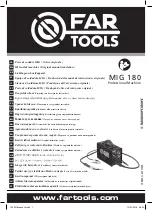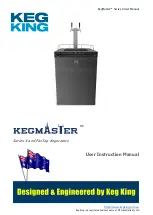
Manual 0-2583
11
INTRODUCTION & DESCRIPTION
torch tip heats and ionizes the gas. The main cutting
arc then transfers to the workpiece through the col-
umn of plasma gas in Zone C.
;;
;;
;;
;
;
;
;
;
;;
;;
A-00002
Workpiece
Power
Supply
+
_
C
B
A
Figure 2-4 Typical Torch Head Detail
By forcing the plasma gas and electric arc through a
small orifice, the torch delivers a high concentration
of heat to a small area. The stiff, constricted plasma
arc is shown in Zone C (Figure 2-4). Direct current
(DC) straight polarity is used for plasma cutting, as
shown in the illustration.
Zone A (Figure 2-4) is used as a secondary gas that
cools the torch. This gas assists the high velocity
plasma gas in blowing the molten metal out of the cut
allowing for a fast, slag-free cut.
B. Gas Distribution
The single gas used is internally split into plasma and
secondary gases.
The plasma gas flows into the torch through the nega-
tive lead, through the gas distributor, around the elec-
trode, and out through the tip orifice.
The secondary gas flows down around the outside of
the torch gas distributor, and out between the tip and
shield cup around the plasma arc.
C. Pilot Arc
When the torch is started a pilot arc is established be-
tween the electrode and cutting tip. This pilot arc cre-
ates a path for the main arc to transfer to the work.
D. High Frequency
Because direct current (DC) alone is not sufficient to
strike and maintain the pilot arc, high frequency is
also used. The high frequency jumps between the tip
and electrode with the DC following.
E. Main Cutting Arc
DC power is also used for the main cutting arc. The
negative output is connected to the torch electrode
through the torch lead. The positive output is con-
nected to the workpiece via the work cable and to the
torch through a pilot wire.
F. Interlocks
One pressure switch acts as an interlock for the gas
supply. If supply pressure falls below minimum re-
quirements the pressure switch will open, shutting off
the DC power, and the GAS indicator will go off.
When adequate gas supply pressure is available the
pressure switch will close, allowing power to be re-
sumed for cutting.
G. Parts-In-Place (PIP)
The torch head has built-in contacts called Parts-In-
Place (PIP). These two contacts are made through the
canted coiled spring inside the shield cup when it is
installed. The torch will fail to operate if these con-
tacts are not made.
A-00458
Torch Switch
PIP Pin
PIP Pin
Shield Cup
To Control
Cable Wiring
Figure 2-5 Parts-In-Place (PIP) Diagram
Summary of Contents for PCH-100XL
Page 2: ......
Page 6: ......
Page 18: ...INTRODUCTION DESCRIPTION 12 Manual 0 2583...
Page 22: ...INSTALLATION PROCEDURES 16 Manual 0 2583...
Page 38: ...SERVICE 32 Manual 0 2583...
















































